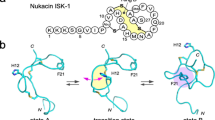Abstract
Studies of small proteins that exhibit noncooperative, gradual (un)folding can offer unique insights into the rarely accessible intermediate stages of the protein folding processes. Detailed experimental characterization of these intermediate states requires approaches that utilize multiple site-specific probes of the local structure. Isotopically edited infrared (IR) spectroscopy has emerged as a powerful methodology capable of providing such high-resolution structural information. Labeling of selected amide carbonyls with 13C results in detectable side-bands of amide I′ vibrations, which are sensitive to local conformation and/or solvent exposure without introducing any significant structural perturbation to the protein. Incorporation of isotopically labeled amino acids at specific positions can be achieved by the chemical synthesis of the studied proteins. We describe the basic procedures for synthesis of 13C isotopically edited protein samples, experimental IR spectroscopic measurements and analysis of the site-specific equilibrium thermal unfolding of a small protein from the temperature-dependent IR data.
Access this chapter
Tax calculation will be finalised at checkout
Purchases are for personal use only
Similar content being viewed by others
References
Garcia-Mira MM, Sadqi M, Fischer N, Sanchez-Ruiz JM, Muñoz V (2002) Experimental identification of downhill protein folding. Science 298:2191–2195
Sadqi M, Fushman D, Muñoz V (2006) Atom-by-atom analysis of global downhill protein folding. Nature (442):317–321
Udgaonkar JB (2008) Multiple routes and structural heterogeneity in protein folding. Annu Rev Biophys 37:489–510
Eaton WA (1999) Searching for “downhill scenarios” in protein folding. Proc Natl Acad Sci U S A 96:5897–5899
Barth A, Zscherp C (2002) What vibrations tell us about proteins. Q Rev Biophys 35:369–430
Tadesse L, Nazarbaghi R, Walters L (1991) Isotopically enhanced infrared spectroscopy: a novel method for examining secondary structure at specific sites in conformationally heterogeneous peptides. J Am Chem Soc 113:7036–7037
Decatur SM (2006) Elucidation of residue-level structure and dynamics of polypeptides via isotope-edited infrared spectroscopy. Acc Chem Res 39:169–175
Huang R, Kubelka J, Barber-Armstrong W, Silva RA, Decatur SM, Keiderling TA (2004) Nature of vibrational coupling in helical peptides: an isotopic labeling study. J Am Chem Soc 126:2346–2354
Manas ES, Getahun Z, Wright WW, Degrado WF, Vanderkooi JM (2000) Infrared spectra of amide groups in alpha-helical proteins: evidence for hydrogen bonding between helices and water. J Am Chem Soc 122:9883–9890
Walsh STR, Cheng RP, Wright WW, Alonso DOV, Daggett V, Vanderkooi JM, DeGrado WF (2003) The hydration of amides in helices; a comprehensive picture from molecular dynamics, IR, and NMR. Protein Sci 12:520–531
Brewer SH, Song BB, Raleigh DP, Dyer RB (2007) Residue specific resolution of protein folding dynamics using isotope-edited infrared temperature jump spectroscopy. Biochemistry 46:3279–3285
Fesinmeyer RM, Peterson ES, Dyer RB, Andersen NH (2005) Studies of helix fraying and solvation using C-13 isotopomers. Protein Sci 14:2324–2332
Marecek J, Song B, Brewer S, Belyea J, Dyer RB, Raleigh DP (2007) A simple and economical method for the production of C-13, O-18-labeled FMOC-amino acids with high levels of enrichment: applications to isotope-edited IR studies of proteins. Org Lett 9:4935–4937
Kubelka J, Keiderling TA (2001) The anomalous infrared amide I intensity distribution in 13C isotopically labeled peptide β-sheets comes from extended, multiple-stranded structures. An ab initio study. J Am Chem Soc 123:6142–6150
Petty SA, Decatur SM (2005) Intersheet rearrangement of polypeptides during nucleation of beta-sheet aggregates. Proc Natl Acad Sci U S A 102:14272–14277
Welch WRW, Kubelka J, Keiderling TA (2013) Infrared, VCD and Raman spectral simulations for β-sheet structures with various isotopic labels, inter-strand and stacking arrangements using Density Functional Theory. J Phys Chem B 117:10343–10358
Welch WRW, Keiderling TA, Kubelka J (2013) Structural analyses of experimental 13C edited amide I' IR and VCD for peptide β-sheet aggregates and fibrils using DFT-based spectral simulations. J Phys Chem B 117:10359–10369
Sagle LB, Zimmermann J, Dawson PE, Romesberg FE (2004) A high-resolution probe of protein folding. J Am Chem Soc 126:3384–3385
Huang CY, Getahun Z, Zhu YJ, Klemke JW, DeGrado WF, Gai F (2002) Helix formation via conformation diffusion search. Proc Natl Acad Sci U S A 99:2788–2793
Hauser K, Krejtschi C, Huang R, Wu L, Keiderling TA (2008) Site-specific relaxation kinetics of a tryptophan zipper hairpin peptide using temperature jump IR spectroscopy with isotopic labeling. J Am Chem Soc 130:2984–2992
Amunson KE, Ackels L, Kubelka J (2008) Site-specific unfolding thermodynamics of a helix-turn-helix protein. J Am Chem Soc 130:8146–8147
Kubelka GS, Kubelka J (2014) Site-specific thermodynamic stability and unfolding of a de novo designed protein structural motif mapped by C-13 isotopically edited IR spectroscopy. J Am Chem Soc 136:6037–6048
Lai JK, Kubelka G, Kubelka J (2015) Sequence, structure and cooperativity in folding of elementary protein motifs. Proc Natl Acad Sci U S A 112:9890–9895
Fabian H, Naumann D (2004) Methods to study protein folding by stopped-flow FT-IR. Methods 34:28–40
Amunson KE, Kubelka J (2007) On the temperature dependence of amide I frequencies of peptides in solution. J Phys Chem B 111:9993–9998
Ackels LA, Stawski P, Amunson KE, Kubelka J (2009) On the temperature dependence of the amide I intensities of peptides in solution. Vibr Spectrosc 50:2–9
Kubelka J (2013) Multivariate analysis of spectral data with frequency shifts: application to temperature dependent infrared spectra of peptides and proteins. Anal Chem 85:9588–9595
Chan WC, White PD (2000) FMOC solid phase peptide synthesis: a practical approach. Oxford University Press, Oxford, UK
Goormaghtigh E, Cabiaux V, Ruysschaert JM (1994) Determination of soluble and membrane protein structure by Fourier transform infrared spectroscopy. II. Experimental aspects, side chain structure, and H/D exchange. In: Hilderson HJ, Ralston GB (eds) Subcellular biochemistry. Plenum, New York, pp 363–403
Acknowledgments
This work was supported by the National Science Foundation (NSF) grant CAREER 0846140.
Author information
Authors and Affiliations
Corresponding author
Editor information
Editors and Affiliations
Rights and permissions
Copyright information
© 2022 Springer Science+Business Media, LLC, part of Springer Nature
About this protocol
Cite this protocol
Kubelka, G.S., Kubelka, J. (2022). Multi-Probe Equilibrium Analysis of Gradual (Un)Folding Processes. In: Muñoz, V. (eds) Protein Folding. Methods in Molecular Biology, vol 2376. Humana, New York, NY. https://doi.org/10.1007/978-1-0716-1716-8_9
Download citation
DOI: https://doi.org/10.1007/978-1-0716-1716-8_9
Published:
Publisher Name: Humana, New York, NY
Print ISBN: 978-1-0716-1715-1
Online ISBN: 978-1-0716-1716-8
eBook Packages: Springer Protocols




